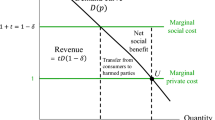Abstract
The purpose of this paper is to describe the implications of the collective model of household behavior for the methods used to estimate the economic value of non-marketed environmental resources. After demonstrating how the separability restrictions inherent in the collective model allow individual preference and household income allocation choices to be distinguished, the paper demonstrates how the framework can be used to recover Hicksian consumer surplus. An algebraic example is used to illustrate how the framework can be used in valuing environmental resources.
Similar content being viewed by others
References
Alderman H., P.A. Chiappori, L. Haddad, J. Hoddinott and R. Kanbur (1995), 'Unitary Versus Collective Models of the Household-Is It Time to Shift the Burden of Proof', World Bank Research Observer 10 (February), 1–19.
Bergstrom, Theodore C. (1997), 'A Survey of Theories of the Family', in M.R. Rosenweig and Oded Stark, eds., Handbook of Population and Family Economics, Vol. 1A. Amsterdam: North Holland.
Blackorby, Charles, David Primont and Robert R. Russell (1978), Duality, Separability and Functional Separability: Theory and Economic Applications. Amsterdam: North Holland.
Blundell, Richard and Jean-Marc Robin (2000), 'Latent Separability: Grouping GoodsWithoutWeak Separability', Econometrica 68 (January), 53–84.
Bockstael, Nancy B. and Kenneth E. McConnell (1993), 'Public Goods in Characteristics of Non-Market Commodities', Economic Journal 103(3), 1244–1257.
Browning, Martin, Pierre-Andrè Chiappori (1998), 'Efficient Intra-Household Allocations: A General Characterization and Empirical Tests', Econometrica 66 (November), 1241–1279.
Carson, Richard T., Wl Michael Hanemann, Raymond J. Kopp, Jon A. Krosnick, Robert C. Mitchell, Stanly Presser, Paul A. Ruud and V. Kerry Smith (1994), Prospective Interim Lost Use Value Due to DDT and PCB Contamination in the Southern California Bight, report to the National Oceanic and Atmospheric Administration. La Jolla; California: NRDA, Inc., September.
Chiappori, Pierre-Andrè (1988), 'Rational Household Labor Supply', Econometrica 56 (January), 63–89.
Chiappori, Pierre-Andrè (1992), 'Collective Labor Supply and Welfare', Journal of Political Economy 100 (June), 437–467.
Dahlberg, M. (1997), 'Household Preferences and the Demand for Local Public Goods', Essay V, Essays on Estimation Methods and Local Public Economics. Economic Studies 31, Department of Economics, Uppsala University.
Deaton, Angus, Javier Ruis-Castillo and Duncan Thomas (1989), 'The Influence of Household Composition on Household Expenditure Patterns: Theory and Spanish Evidence', Journal of Political Economy 97 (February), 179–2000.
Dellaert, Benedict G.C., Mia Prodigalidad and Jordan J. Louviere (1998), 'Family Members' Projections of Each Other's Preference and Influence: A Two-Stage Conjoint Approach', Marketing Letters 9(2), 135–145.
Diewert W. Erwin (1977), 'Generalized Slutsky Conditions for Aggregate Consumer Demand Functions', Journal of Economic Theory 15 (August), 353–362.
Doss, Cheryl R. (1996), 'Testing Among Modes of Intrahousehold Resource Allocation', World Development 24(10), 1599–1609.
Hanemann, W. Michael and Edward Morey (1992), 'Separability, Partial Demand Systems, and Consumer's Surplus Measures', Journal of Environmental Economics and Management 22 (May), 241–258.
Hausman, Jerry A. (1981), 'Exact Consumer's Surplus and Deadweight Loss', American Economic Review 71 (September), 662–676.
Hersch, Joni and Leslie S. Stratton (1994), 'Housework, Wages and the Division of Housework Time for Employed Spouses', American Economic Review, Papers and Proceedings 84 (May), 120–125.
Kooreman, Peter and Arie Kapteyn (1987), 'A Disaggregated Analysis of the Allocation of Time within the Household', Journal of Political Economy 95 (April), 223–249.
Larson, Douglas M. (1991), 'Recovering Weakly Complementary Preferences', Journal of Environmental Economics and Management 21 (September), 97–108.
Lundberg, Shelly J., Robert A. Pollak and Terance J. Wales (1997), 'Do Households and Wives Pool Their Resources? Evidence from the United Kingdom Child Benefit', Journal of Human Resources 32(3), 463–480.
Pollak, Robert A. and Terrence J. Wales (1981), 'Demographic Variables in Demand Analysis', Econometrica 49 (November), 1533–1551.
Quiggin, John (1998), 'Individual and Household Willingness to Pay for Public Goods', American Journal of Agricultural Economics 80 (February), 58–63.
Smith, V. Kerry and H. Spencer Banzhaf (2003), 'A Diagrammatic Exposition of Weak Complementarity and the Willig Condition', American Journal of Agricultural Economics (in press).
Vartia, Yrjo O. (1983), 'Efficient Methods for Measuring Welfare Change and Compensating Income in Terms of Ordinary Demand Functions', Econometrica 51 (January), 79–98.
Whittington, Dale (1998), 'Administering Contingent Valuation Surveys in Developing Countries', World Development 20(1), 21–30.
Author information
Authors and Affiliations
Corresponding author
Rights and permissions
About this article
Cite this article
Smith, V.K., Van Houtven, G. Recovering Hicksian Consumer Surplus within a Collective Model: Hausman's Method for the Household. Environmental and Resource Economics 28, 153–167 (2004). https://doi.org/10.1023/B:EARE.0000029916.05630.89
Issue Date:
DOI: https://doi.org/10.1023/B:EARE.0000029916.05630.89




